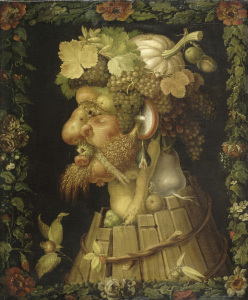Tonight, by the almanac, autumn begins in the Northern Hemisphere. The precise moment, for those of you who like precision, is 10:29 PM here in Lake Worth. That’s Eastern Daylight Time, so you can do the math accordingly to where you live. Precision is great, but I am more of a roundabout kind of guy, and I am more of a traditionalist, anyway, of the mindset that autumn began with Lammas, the celebration of the first harvest, at the start of August. By this traditional reckoning of time, we are now midway through autumn, and we are also now midway between the year’s longest day (Summer Solstice, or Midsummer) and its longest night (Winter Solstice, or Midwinter). Tomorrow we inch closer to darkness, crossing a border that begins to make nights longer than days in our hemisphere. But for now, we are balanced, and this, hopefully, is reflected in us.
The time of gathering in intensifies now, for as darkness overtakes light, cold increases, as does our sense of urgency, and even in these times of plenty, when we can have almost anything we want at any time of year (should we wish it), still we instinctually gather in and take more joy in home and in hearth. And so now we balance what was the opening aperture of spring at the opposite side of the seasonal round with gathering, storing, closing. Winter is coming; naturally, we want to make it as warm and comfortable as we can.
Here in South Florida, whereas spring comes early, so autumn comes late. It’s still quite summery out there for us. But Orion is there lording over the early morning darkness before the sun rises to the east, and occasionally we wake up to a slightly less humid day. The air is growing lighter, less still. We begin to play with the idea of shutting off the air conditioning and throwing open the windows. But that’s Florida for you: often a little contrary to the rest of the country. Nonetheless, soon the big green leaves of the Florida Almond trees will begin turning red. They are not widely planted, and they are wall flowers for most of the year, but each autumn for a couple of weeks they make their presence known. There’s one across the street in Old Aunt Sarah’s lot. Sometimes I walk on over and stand under that blazing red tree and even though it may be 80 degrees all around me, I look up into those red leaves and pretend that I am in a place where autumn makes itself well known.
If you are in one of those places, go, gather some apples, visit a farmer who grows pumpkins (like Intervale Farm in New Gloucester, Maine… that’s all Jan Wilcox grows there), find someone who makes cinnamon doughnuts and tells good stories. Pour yourself some cider, hard or fresh, either is fine, raise your glass to Seth and me, and we will do the same from here. It just won’t be as chilly here, and the colors won’t be nearly as beautiful.
Image: Autumn by Giuseppe Arcimboldo. Oil on canvas, 1573, [Public domain] via WikiMedia Commons.


